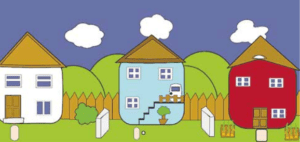Neighbors
Let’s put Neighbor back in the Neighborhood
by Robin Bush, Outreach Director

Fast forward to 2019. Homes that were once built around a central common space where folks gathered, are lined up side-by-side down long streets. People build fences between houses, and value privacy. People who used to spend time outdoors, seeing people and gathering stories that wove their lives together, now work inside and engage with their screens, seldom talking with each other. Many of us are strangers to those who live nearby. You may have a hundred “friends” on Facebook, but what does that mean? Are any of those “friends” neighbors in the full sense of the word? Having online “friends” is an indicator that we still want to share our lives, be known, and know others. Even though we live complex lives, and cozy porch conversations are a dim memory, what we crave is connection. Being a neighbor may mean my house is near yours and we’ll care and watch out for each other within the limits of our mutual privacy boundaries. Our neighbors may also be people we see in town each week, at church, or at the gym. Our neighbor is anyone with whom we are neighborly.
You know what “being neighborly” feels like. It’s being friendly, helpful, and responsible for each other, not just in times of crisis, but every day. It’s time spent together in conversation. Neighborliness is the gift you receive by giving and one of the most rewarding gifts you can receive. When we share our lives, we strengthen our bonds of community.
Do you know your neighbors’ rhythms enough to recognize when something is out of the ordinary? Or, think about the older gentleman two doors away who is served by Meals on Wheels at lunch. Can you bring him a few cookies next time you make a batch? Little things make everyone feel cared for, and that is the root of neighborliness. Your neighbors are the ones you invite to join you for holidays, to come to a tea party, a 4th of July BBQ, or to build an emergency preparedness team. My grandmother and her neighbor across town checked in on each other every day. No matter what the weather, they saw each other at least twice a week. Each would do anything to help the other. Grandma called it part of having “good old-fashioned values.” “Being neighborly matters,” she’d say. What was true nearly 100 years ago is still true today. Remember.
For some, this can be a lonely world. There is a slope toward loneliness and isolation in aging, particularly for those who live by themselves. According to Peter Lovenheim, author of the book, In the Neighborhood, more than a quarter of all US households now consist of a home of one. That’s almost 30 million people with no one to go home to at night. For seniors, after a life of giving to others, being left out in their later years leads to serious issues for health and emotional wellbeing. Mother Teresa of Calcutta once said in A Simple Path, “The biggest disease in the West today is not TB or leprosy; it is being unwanted, unloved, and uncared for.” What can you do? Keep your eyes out for who needs a bit of neighborliness. Replace the chats over the backyard fence of yester-year with invitations to have someone join you for supper or a walk in the woods. Conversation and connection help people feel included, wanted, and needed. It doesn’t require much money or time to make someone feel appreciated. Their gratitude is a priceless reward.
Neighborliness has no age range; it bridges generations. The single mother with three young kids, a grandmother she drives to the store, and a lawn that needs clearing of all the branches that came down in our winter windstorms needs you to invite her to share a cup of tea, so she has someone to talk with. The elderly man who lives alone, standing at the window, watching children playing in the street, remembering when his own children were small and missing those times long-gone, needs you. He too will treasure a cup of tea and someone to talk with.
When you spend time with someone, you both get the gift of time shared. As your friendship grows, you’ll have someone to turn to when suddenly you have a roof leak and can’t climb a ladder to put up a tarp, or someone to feed and walk your dog when you’re away. Your neighbor, in turn, will reach out to you when they need a hand and an arm to lean on. Christina Baldwin, on our Board of Directors, has set a theme for 2019 in our monthly publication, Island Times: “Ask for what you need and offer what you can.” It’s the heart of our community.
What will you do today to put neighbor back in the neighborhood?
